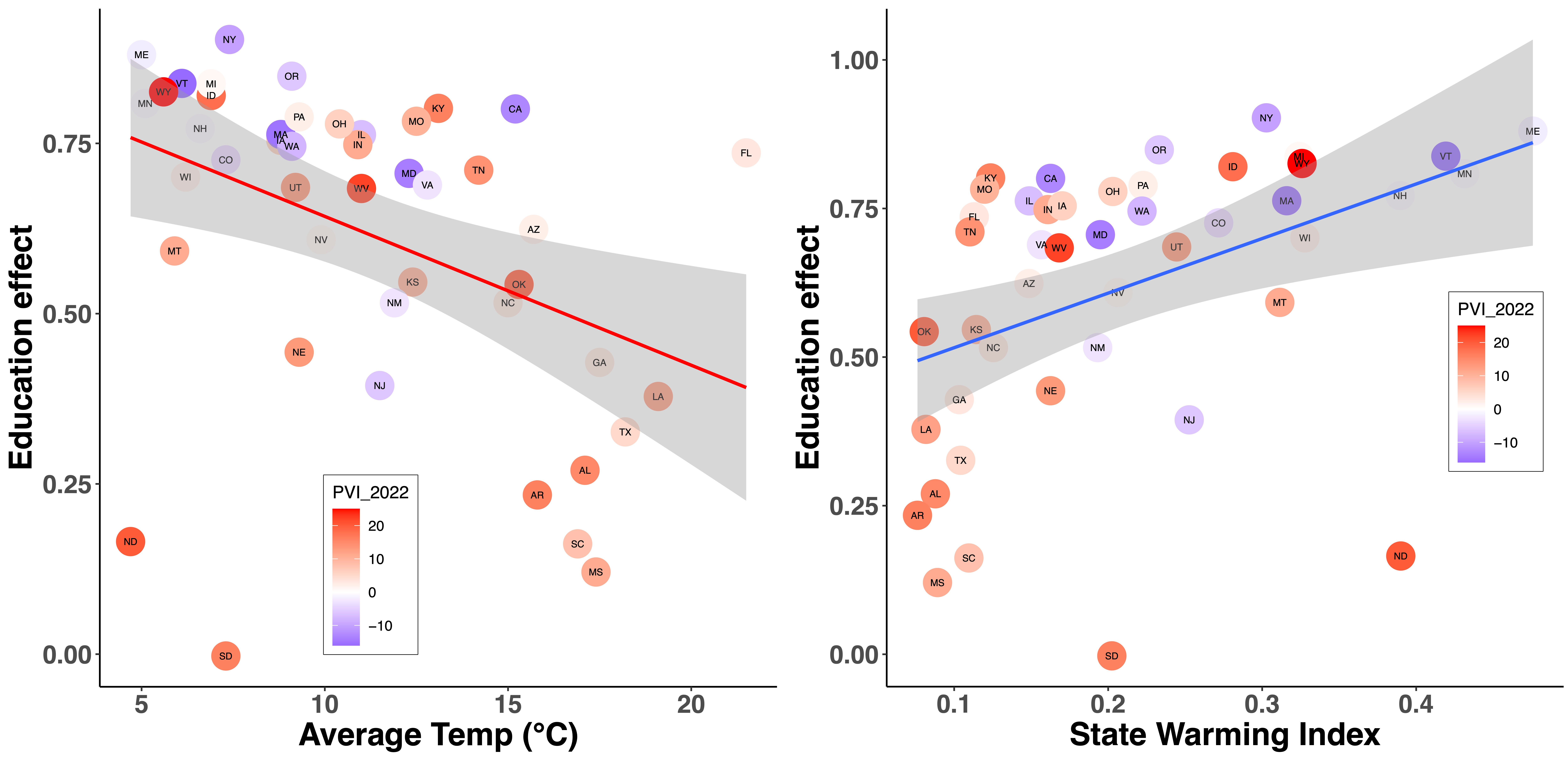Learning is believing: Education and climate concern
Published in Social Sciences, Earth & Environment, and Plant Science

Maybe you once took a natural science class that changed how you experienced the outdoors. I remember, years ago after an Earth sciences class at the University of Wisconsin, noticing the minerals in the stones at my feet and how glacial moraines differed from the hills of the Driftless Area in southern Wisconsin.
This was the 1990s, when climate change was just barely perceptible in northern states like Wisconsin— Lake Mendota freezing later in the winter, the early appearance of spring flowers. That science class helped me also understand what was happening.
Education level and political affiliation are two of the strongest predictors of climate change concern in the U.S. The figure below (left) shows the correlation between education levels and climate concern, using Census data on bachelor’s degrees across 3,048 U.S. counties alongside Yale Climate Opinion data from those counties. While this correlation is well-known, notice the colors indicating average warming over the past decade, which suggest that education combined with recent warming leads to the highest levels of concern.
At the same time, the two main US political parties differ substantially in perspective on climate change. The right side of the figure below shows how voting in the 2020 election predicts climate concern, even better than education does.

In our paper in npj Climate Action, we find that education is more the causal factor, whereas politics are more a reflection of people voting for the party that reflects their views. So let's look more closely at education.
Across the counties of each US state, there is a positive correlation between climate concern and percentage of adults with bachelors degrees. In many southern states, like Alabama, Mississippi and Texas, this correlation—"Education Effect"— is small compared to what it is northern states, like Maine, Vermont or Michigan .

The colder states have a larger Education Effect (figure above, left). Is climate change more noticeable in the North? After all, a one-degree warming in Florida is not as noticeable as a one-degree warming in Maine.
To capture this, we defined a relative warming index for each US state. We just divide the average temperature increase over the last decade (in Celsius) by its mean annual temperature. Call it the "State Warming Index." Now look what happens in the figure above (right): the Education Effect increases with this State Warming Index.
In our paper, we argue that this shows how education leverages local warming into public concern. The more perceptible is local warming, like in the cold climates, the more education increases climate concern. In the hotter climates, however, warming is less noticeable and the Education Effect is smaller because there is less for science to explain.
A few concerns one might have about our analysis. First, can we separate out the effect of politics? After all, many of the warmer southern states are also more politically conservative. The circles in the figure above are colored by the Cook Partisan Voter Index, showing more blue states with high Education Effect and red states with low Education Effect. But education still matters—in our paper, we showed how the correlations are still there when we controlled for politics (% democratic vote in the 2020 election).
Another question—looking at the figure above— what is going on with North and South Dakota? They are cold states but their Education Effect is relatively small. In our paper, we suggested this might be due to fossil fuels being exceptionally important to their state economies, but we leave that open for further study.
Our takeaway: education drives climate concern, while politics reflects existing attitudes. Lasting progress is more likely to come through education and personal experience. How quickly the public responds to warmer winters, extreme temperatures, and events like floods, droughts, and wildfires will depend on education levels. Already, three-quarters of Americans recognize that global warming is happening. Among younger generations — living with climate change and whose interest in science predicts greater trust in climate research —education can have a powerful effect.
Bentley, R.A., Horne, B.D. Perceptible climate warming amplifies how education increases climate concern in the US. npj Clim. Action 4, 12 (2025). https://doi.org/10.1038/s44168-025-00219-4
Follow the Topic
-
npj Climate Action

This journal considers research that explores all aspects of mitigating the hazardous effects of global climate change.
Related Collections
With Collections, you can get published faster and increase your visibility.
AI-Driven Systemic Change for Climate Resilience
Publishing Model: Open Access
Deadline: Feb 01, 2026
Climate Activism: Bridging Science, Advocacy, and Public Engagement
Publishing Model: Open Access
Deadline: May 28, 2026





Please sign in or register for FREE
If you are a registered user on Research Communities by Springer Nature, please sign in